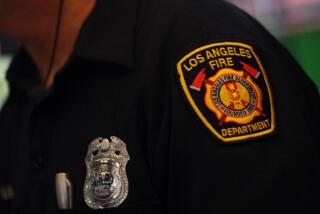Mysterymobile : Car Purchased for $60,000 by Camarillo Dealer Baffles Auto Experts
- Share via
CAMARILLO — For the star of a mystery story that has baffled car aficionados from around the world, the exotic, two-seater sports car, circa 1958, is unprepossessing.
It sits on blocks under a Camarillo carport, little more than a rusting shell, surrounded by old appliances and cardboard boxes.
Exposure to the elements in the small Argentine town where it sat for decades in a grassy field has scoured the car’s heavy steel body, leaving flaking vestiges of the bright red paint and white racing stripes that once adorned it. The floorboards have long since rotted away and the seats were ripped out, yet it retains a wooden steering wheel and one of the smaller Ford V-8 engines.
A Camarillo sports car dealer and thrill seeker purchased the unidentified car six years ago for more than $60,000.
Robert Overacker made the trek to South America in the belief the car was a vintage Ferrari. It wasn’t.
He purchased it anyway, thinking it might be a rare Aston Martin. It isn’t.
It wasn’t the only gamble Overacker took and lost.
He died in October 1995 at age 39 while attempting to ride a Jet Ski over Niagara Falls. His parachute failed to open.
But the car remains in Camarillo, and his widow, Laurie, is still trying to solve the mystery.
Automobile experts, drawn by ads Overacker placed in specialty magazines that serve the close-knit world of expensive sports cars, have been unable to identify it. The speculation is the vehicle may be a one-of-a-kind, custom-built race car.
“It’s always been known as the mystery car,” said Chris Yeomans, the mechanic who restored the dozens of cars Overacker once owned. “People from all over the world have looked at this car. . . . Most people find it interesting, but it’s not a pretty sight at this point.”
Still, for car buffs like Overacker, the fascination was clear.
Excited by the prospect of finding a rare car, Overacker flew to Argentina with an acquaintance who brokered the deal. Then he drove 11 hours through the Andes on snowy, winding mountain roads and finally hopped on a private plane for a five-hour flight to the small town of San Rafael in the foothills of the Andes near the Chilean border.
There he found the curious car and an equally curious populace wondering what sort of drug deal the rich American was concocting, said Laurie Overacker. The assumption was incorrect, but not so far from the truth for a man who traded cars most of his life, raced cars at Ventura and Saugus speedways and harbored dreams of becoming a Hollywood stunt man.
“If Bob was here, he would say he was a car enthusiast who got out of hand and bought and sold to support his habit,” she said, adding that his purchase was fueled by fear that he might miss out on a valuable automobile.
“We didn’t know what it wasn’t until we got it here,” Overacker said, sitting in her late husband’s office, still crammed with automobile memorabilia. “When you’re a trusting soul, you expect everyone else to be trusting as well. It was a good year or two before he realized he got stung.”
Still, the car has an evocative, nostalgic charm that offers tantalizing hints of a possible storied past.
It sports a grille and body styling that draws inspiration from early Aston Martins. Built on what is believed to be a Ford chassis, it boasts Borrani wire wheels common to such Italian sports cars as Maseratis and what may be a Mercedes-Benz rear suspension.
“We think it’s pretty much a Frankenstein that somebody put together,” Laurie Overacker said.
Although originally a convertible, an aluminum roof was added later. A fading emblem reads: Automovil Midget Club Sanchales. With its sturdy yet leaden frame, dual gas tanks and even glove compartment, the car was unlikely to win any sprints if it ever did race.
Hector Castro, 48, an Argentine native who runs a car restoration business in Atascadero, doubts the car ever ran. Such cars were common in a country that saw virtually no imported automobiles from the end of World War II until the 1960s, he said.
“It’s a purely handmade car,” Castro said. “I’ve seen a lot of that stuff. People in my town . . . tried to make an old jalopy look like a Ferrari, and that’s what happened with this car.”
But until Laurie Overacker receives a positive identification, she intends to hang on to her intriguing, if expensive, mystery tale.
Besides, the car has sentimental value, exemplifying her late husband’s devil-may-care attitude toward life. “He was a daredevil, live-on-the-edge kind of guy,” she said. “What he wanted to do, he did, whether it was a successful venture or not.”






